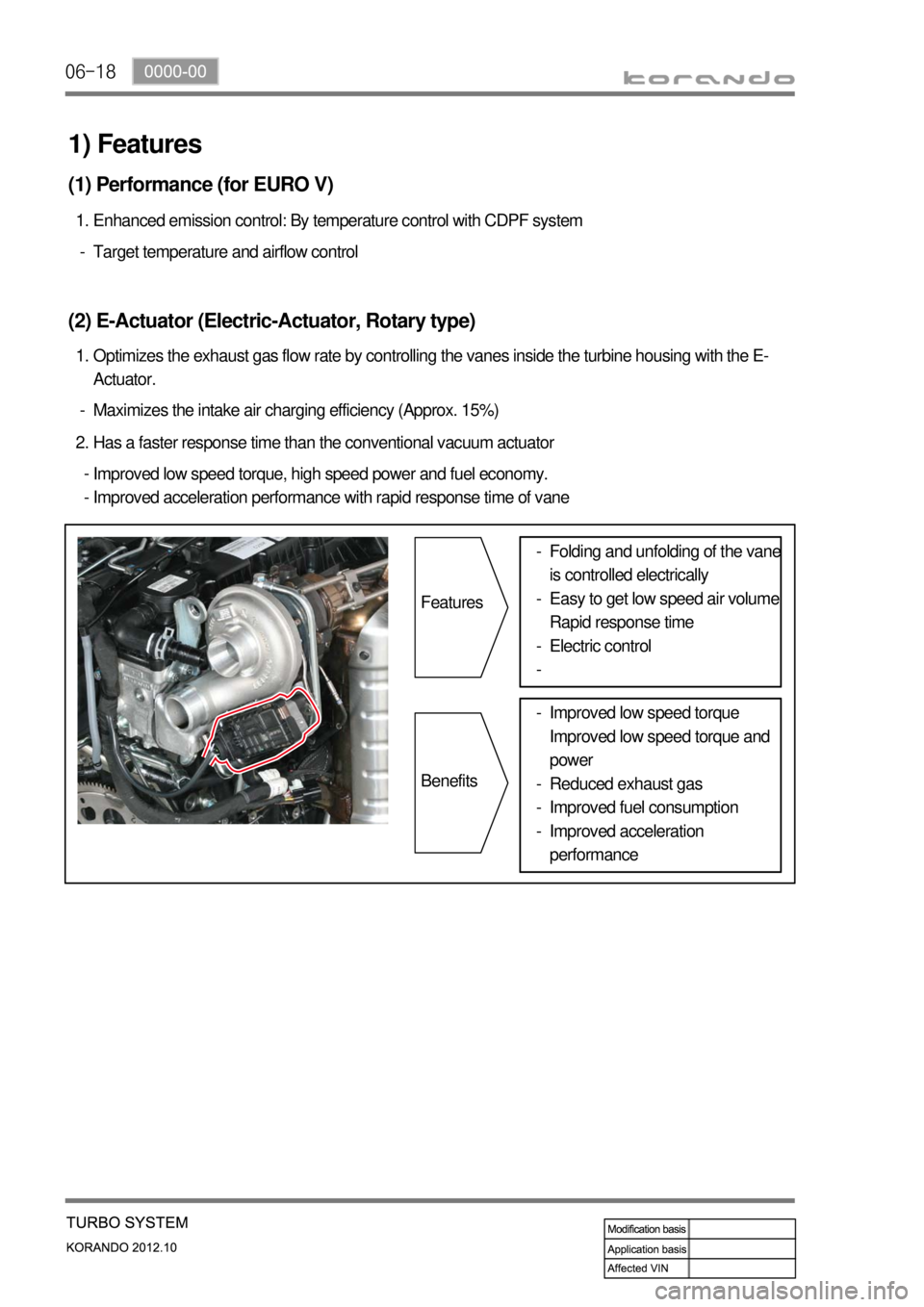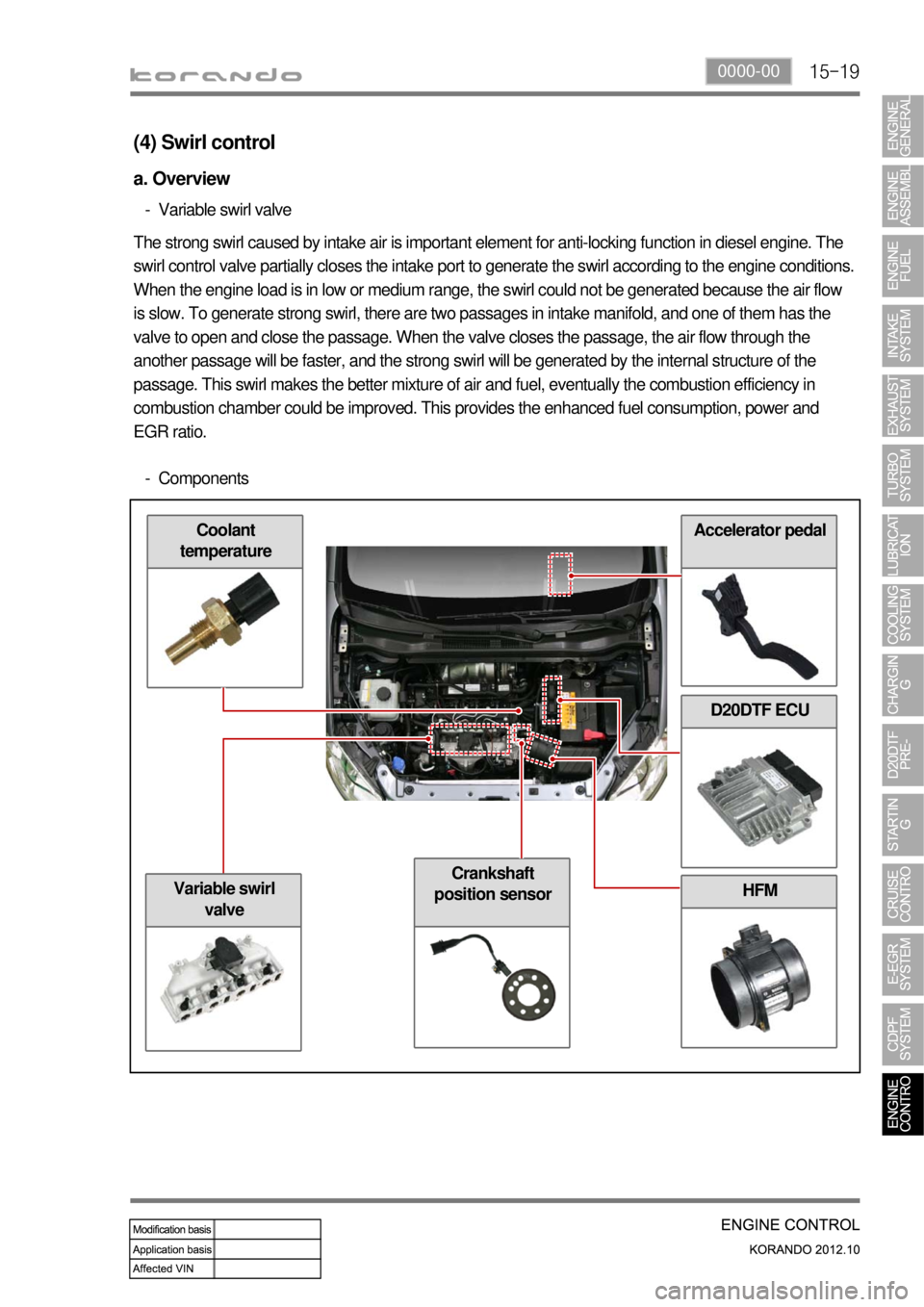fuel consumption SSANGYONG KORANDO 2012 Service Manual
[x] Cancel search | Manufacturer: SSANGYONG, Model Year: 2012, Model line: KORANDO, Model: SSANGYONG KORANDO 2012Pages: 1082, PDF Size: 96.1 MB
Page 195 of 1082

06-18
Maximizes the intake air charging efficiency (Approx. 15%) -Optimizes the exhaust gas flow rate by controlling the vanes inside the turbine housing with the E-
Actuator. 1.
(2) E-Actuator (Electric-Actuator, Rotary type)
Target temperature and airflow control -Enhanced emission control: By temperature control with CDPF system 1.
(1) Performance (for EURO V)
Has a faster response time than the conventional vacuum actuator 2.
Improved low speed torque, high speed power and fuel economy.
Improved acceleration performance with rapid response time of vane -
-
1) Features
Features
BenefitsFolding and unfolding of the vane
is controlled electrically
Easy to get low speed air volume
Rapid response time
Electric control -
-
-
-
Improved low speed torque
Improved low speed torque and
power
Reduced exhaust gas
Improved fuel consumption
Improved acceleration
performance -
-
-
-
Page 295 of 1082

15-190000-00
HFM
Accelerator pedalCoolant
temperature
(4) Swirl control
a. Overview
Variable swirl valve -
The strong swirl caused by intake air is important element for anti-locking function in diesel engine. The
swirl control valve partially closes the intake port to generate the swirl according to the engine conditions.
When the engine load is in low or medium range, the swirl could not be generated because the air flow
is slow. To generate strong swirl, there are two passages in intake manifold, and one of them has the
valve to open and close the passage. When the valve closes the passage, the air flow through the
another passage will be faster, and the strong swirl will be generated by the internal structure of the
passage. This swirl makes the better mixture of air and fuel, eventually the combustion efficiency in
combustion chamber could be improved. This provides the enhanced fuel consumption, power and
EGR ratio.
Components -
D20DTF ECU
Crankshaft
position sensor
Variable swirl
valve
Page 669 of 1082

05-6
SVC class
Previous Current
Changed from figure type to bar graph type.
6) Average fuel economy reset and calibrated automatically when
refilling
7) Instant fuel consumption display changed
8) Pre-warning indicator for engine overheat removed
Both SVC and STD class
Previous Current
Reset by user Reset by user and automatic reset when refilling
9) TDMS logic changed
SVC class
Current
TDMS (Tier Direction Management System) is not displayed when EPS warning lamp comes on.
SVC class STD class
Pre-warning indicator for engine overheat is removed.
EPS warning lampTDMS displayLCD not displayed
EPS warning lamp
comes onLCD screen is not
displayed.
Page 702 of 1082

05-398010-01
Function Signal Remark
Display type 3 digits LCD
Display range 0.0 km ~ 99.9 km
(0 miles~99.9 miles)
Resolution 0.1 km (mile)
Display interval every 10 seconds
Data clear - Disconnect B+
voltage
- Press and hold Reset
switch for more than
1 sec.
- Reset automatically
when refilling
(2) Average Fuel Consumption Mode
The LCD display indicates average fuel consumption calculated based on total driving distance and total
fuel consumption since B+ power supply or data reset.
(3) Instant Fuel Consumption Mode
The LCD display indicates the instant fuel consumption (for 2 seconds) calculated based on driving
distance and fuel consumption for last 2 seconds.
Function Signal Remark
Display type 3 digits LCD
Display range 0.0 ~ 99.9
(MPG, ℓ/100 km, km/ℓ)
Resolution 0.1 km (mile)
Display interval every 2 seconds
Page 703 of 1082

05-40
When the ignition is switched on and the vehicle is drived more than 10 km, average fuel consumption
is displayed at every 200 ms, based on the fuel consumption and driving distance for 600 ms. -
Function Signal Remark
Display type DOT BAR TYPE(92DOT)
Display range0.0 ~ 20(ℓ/100km, km/ℓ)/ 0.0 ~ 50(MPG)
Resolution
(DOT)0.2174(ℓ/100km, km/ℓ per Bar),
0.5435(MPG per Bar)
Display intervalevery 200ms(25℃)
Page 708 of 1082

05-458010-01
Pin No.Message
Operating condition
Ambient temperature:
indicates air temperature
outside controlTRIP switch
Trip AReset: Press and hold the Trip switch
for more than 1 second
Trip BReset: Press and hold the Trip switch
for more than 1 second
Distance to empty:
indicates a distance can be
driven with the fuel remaining
controlFactory-setting mode
Average fuel consumption:
indicates average fuel
controlReset: Press and hold the Trip switch
for more than 1 second
Instant fuel consumption:
indicates fuel consumption for
a short periodsTRIP switch
Illumination brightness:
indicates tail lamp brightness
controlBrightness control: Press and hold the
Trip switch for more than 1 second
Start-up screenDisplayed for 2 seconds right after
ignition is switched on
Driver's seat belt
reminderDisplayed for 4 seconds after
'WELCOME' screen
DOT LCD message display ▶
Pin No. Message Operating condition
Page 733 of 1082

06-22
Hazard warning flasher switch
When this switch is pressed, the hazard
warning flashers blink.
Windshield heated glass switch
This is to prevent the windshield wiper blades
from being frozen.
The heated wire operates for about 12
minutes. Press the switch again to stop the
operation.
The indicator in the switch comes on when in
use.
TRIP/Reset switch
Whenever pressing this button, the
information is displayed in the following order:
Odometer, Trip A, Trip B, Distance to empty,
Average fuel consumption, Instant fuel
consumption, Illumination level, Ambient air
temperature (for STD); Trip A, Trip B,
Distance to empty, Average fuel
consumption, Instant fuel consumption,
Illumination level, Ambient air temperature
(for SVC). Press and hold this button to
initialize (reset) Trip A/Trip B and average fuel
consumption, adjust illumination level or
change the unit of temperature.Rear glass/outside
mirror heated wire switch
Press this switch to turn on the tailgate and
outside rearview mirror heated wire. The
heated wire operates for about 12 minutes.
Press the switch again to stop the operation.
The heated glass will operate for about 6
minutes when the switch is pressed again
within 10 minutes after completion of its first
operation cycle.
The indicator in the switch comes on when in
use.
Page 736 of 1082

06-258510-00
SVC class instrument cluster
TRIP A TRIP B
(3) Trip switch
Whenever pressing this button, the information is displayed in the following order: Odometer, Trip A, Trip
B, Distance to empty, Average fuel consumption, Instant fuel consumption, Illumination level, Ambient air
temperature (for STD); Trip A, Trip B, Distance to empty, Average fuel consumption, Instant fuel
consumption, Illumination level, Ambient air temperature (for SVC). Press and hold (for more than 1 sec)
this button to initialize (reset) Trip A/Trip B and average fuel consumption, adjust illumination level or
change the unit of temperature.
Description ▶
The factory setting is DTE mode. ※ Display
Mode
SwitchDetecting
timeFunction
Briefly
and holdBelow 1
second
(60 to
980 ms)STD- Mode change
(Odo→Trip A→Trip B→DTE
<00470047004702e70068009d008c00990088008e008c0047008d009c008c00930047008a00960095009a009c00940097009b00900096009502e700700095009a009b00880095009b0047008d009c008c00930047008a00960095009a009c00940097009b00
9000960095>
→Illumination level→Ambient air temperature)
SVC- Mode change
(Trip A→Trip B→DTE→Average fuel consumption
→Instant fuel consumption→Illumination level
→Ambient air temperature)
Press
and holdOver 1
seconds- Reset
(Trip A, B, average fuel consumption)
- Change
<004700470047004f007000930093009c0094009000950088009b00900096009500470093008c009d008c00930047004f005d0047009b009600470058005000530047009b008c00940097008c00990088009b009c0099008c0047009c00950090009b004700
4f0b4502e90d9100500050>
Not
pressOver 3
seconds- Mode change
<004700470047004f007000930093009c0094009000950088009b00900096009500470093008c009d008c009302e70068009400890090008c0095009b00470088009000990047009b008c00940097008c00990088009b009c0099008c02e70076008b009600
50>
STD class instrument cluster
TRIP A TRIP B
Page 844 of 1082

02-10
2) Transaxle Cooling
The transaxle cooling system ensures rapid warm-up and constant operating temperature resulting in
reduced fuel consumption and refined shift quality.
It also includes a cooler by-pass within the hydraulic system to allow sufficient lubrication to the transaxle
drivetrain in the event of a blockage in the transaxle cooler.
3) Shift Strategy
Gear Change ▶
Transaxle gear change is controlled by the
TCU. The TCU receives inputs from various
engine and vehicle sensors to select shift
schedules and to control the shift feel and
torque converter clutch (TCC) operation at each
gear change.
Coast down ▶
Coast down down shifts occur at 0% pedal
when the vehicle is coasting down to a stop.
Torque Demand ▶
Torque demand down shifts occur
(automatically) when the driver demand for
torque is greater than the engine can provide at
that gear ratio. If applied, the transaxle will
disengage the TCC to provide added
acceleration.
Page 873 of 1082

03-133660-01
2) Transaxle Cooling
The transaxle cooling system ensures rapid warm-up and constant operating temperature resulting in
reduced fuel consumption and refined shift quality.
It also includes a cooler by-pass within the hydraulic system to allow sufficient lubrication to the transaxle
drivetrain in the event of a blockage in the transaxle cooler.
3) Shift Strategy
Gear Change ▶
Transaxle gear change is controlled by the
TCU. The TCU receives inputs from various
engine and vehicle sensors to select shift
schedules and to control the shift feel and
torque converter clutch (TCC) operation at each
gear change.
Coast down ▶
Coast down down shifts occur at 0% pedal
when the vehicle is coasting down to a stop.
Torque Demand ▶
Torque demand down shifts occur
(automatically) when the driver demand for
torque is greater than the engine can provide at
that gear ratio. If applied, the transaxle will
disengage the TCC to provide added
acceleration.